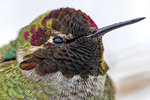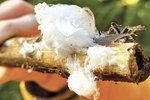

Q: What’s with the hummingbirds in January? Are they dive-bombing? I thought the high-pitch chirp was a squirrel, but those are hummingbirds?
— Megan Schowalter, Longbranch
A: If you have been stopped by the darn-near supersonic chirp of a male Anna’s hummingbird — watch it climb again, 100 feet in the air, warbling its faint electrical song, then shoot Earthward like a bullet before giving that chirp as it pulls out of its dive — then you have seen a bird take it to the limits.
Step aside, peregrine falcon. In its dive, an Anna’s hummingbird reaches the highest speed-to-body-length ratio ever recorded in a vertebrate, 385 lengths per second. (The falcon clocks in at 200.) It is a display flight, usually performed just above the head of a watching female hummingbird. It has five stages. First, it flaps straight downward, which is saying something, as Anna’s hummingbirds already achieve 215 body lengths per second in level flight. Second, it tucks its wings. Third, it spreads its wings and begins to pull up.
Here it approaches 10 g-forces, the highest force due to acceleration of any voluntary flight maneuver; fighter pilots can sustain up to 9, the average person about 5. Other birds rarely break 2 g-forces. Hummingbirds have been clocked at 4 g-forces when making sudden escape flights. Researchers estimate that while an Anna’s hummingbird’s wing bones are unlikely to crack at 10 g-forces, the attachment points of their wing muscles are right on the edge of what they can handle.
What makes the sound? The fourth stage of the dive lasts five-hundredths of a second. The hummingbird flares its tail. When it does, two tail feathers flap like flags. The chirp they make is the musical note C, four octaves above middle C, layered with harmonics — which strangely corresponds with a prominent vocal chirp in the hummingbird’s song. The mechanically produced note is 10 times louder than what its tiny voice box is capable of.
Fifth, the hummingbird flaps once, closes its tail, and glides on to whatever it wants to do next. Often it heads straight back up, to snap its entire being once again.
These display flights begin in the first sunny days of January and last throughout the spring, though January is too early for hummingbirds to breed in the cool, wet Pacific Northwest.
But it is not too early in the Anna’s hummingbird’s ancestral home. Like barred owls, Anna’s hummingbirds are newcomers to the Key Peninsula. Originally confined to the chaparral and scrub oak of Baja and Southern California, they were uncommon birds. The desiccating heat of Californian summer and fall meant that each year they had to survive several months of a nectar minimum. In the chaparral, manzanita and currants begin to bloom in November, and Anna’s hummingbirds begin to nest in January, strange timing for a North American bird.
Their march northward in the last 70 years has been dramatic. All research suggests it is due to human-wrought changes in the landscape. In the early 1900s, timber companies made massive plantings of eucalyptus in California. The trees bloom from fall through spring, offering abundant nectar. Anna’s hummingbirds exploded in population.
Soon they began to spill north and east. The first northwest nest was in Victoria in 1958; the first Washington nest was in Tacoma in 1976. And they did best in the landscaping around human development, with its wide diversity of blooming ornamentals. Scientists call this ecological release: When the constraining factor of the yearly nectar minimum was released, the hummingbirds responded. Now they are wintering in parts of Alaska and Idaho.
Our gardens and nectar feeders have drawn this species into close companionship with us.
Q: When the temperature dropped recently, I found some beautiful strands of ice sprouting from a piece of wood on the ground. They looked like feathery locks of hair. Can you tell us more about what it is and how it happens?
— Anna Brones, Vaughn
A: You saw something rare. I saw it that morning too. What got me was its texture, like cotton candy, airy yet resistant to melting or fracture. Another name for it is wool ice. The temperature had risen slightly above freezing and no other frost was around, making the patches of hair ice stand out like lilies on the dark forest floor.
Hair ice only forms in forests between latitudes 45 and 55 degrees north, and only when the air is damp and the temperature slightly below freezing. It only grows from the downed branches of deciduous trees like alder, and only from bare wood. Each strand is two-tenths of a millimeter thick, rooted in the pore of a wood ray.
A naturalist hero of mine, Alfred Wegener, who proposed that continents drift decades before the field of geology came around to the idea, studied hair ice and suggested it might be the creation of a fungus.
In 2015, after a century, he was proven correct. Hair ice only grows in the presence of a crust fungus, Exidiopsus effusa. When researchers killed the fungus, the ice that formed at the mouths of the wood rays quickly recrystallized into shapeless gobs. In the words of the researchers, “hair ice is doped with a recrystallisation inhibitor.” In other words, the fungus gives hair ice its incredible properties.
Researchers remain focused on learning how. Melted hair ice is full of scattered lignin molecules. Lignin forms the cell walls in wood, which is broken apart by fungal digestion. Perhaps lignin is responsible; perhaps not.
Meanwhile, I’m tempted to ask why. As in, why would the fungus create hair ice? Such a question is always risky business — ascribing intention to things like fungi — yet if I’ve learned anything about this wild, multilayered world, it’s that whenever we follow Wegener’s lead and pursue fantastical hypotheses, we find the world to be thick with hidden purposes.
Here is my half-baked idea. What if hair ice helps the fungus get ahead in life by pushing bark away from wood, giving the fungus more bare wood to colonize? That’s mostly pure speculation. But I did find several growths of hair ice that had pushed bark away from the wood, even a few where the bark had been split like a jacket unzipped.
UNDERWRITTEN BY THE FUND FOR NONPROFIT NEWS (NEWSMATCH) AT THE MIAMI FOUNDATION, THE ANGEL GUILD, ADVERTISERS, DONORS AND PEOPLE WHO SUPPORT INDEPENDENT, NONPROFIT LOCAL NEWS